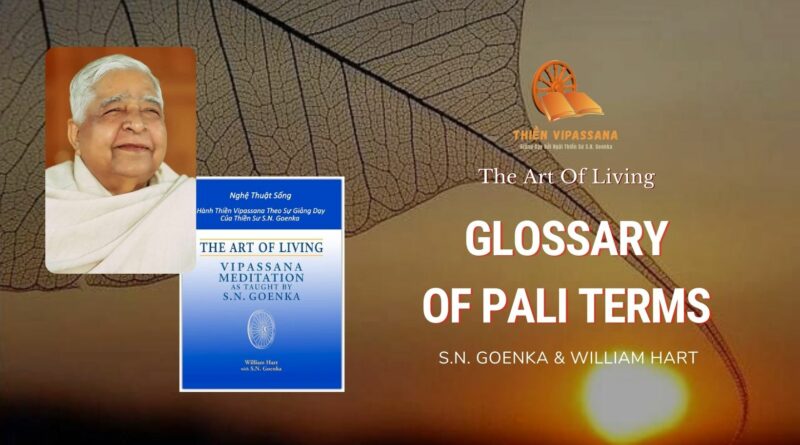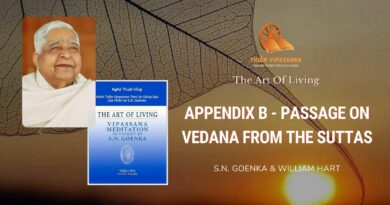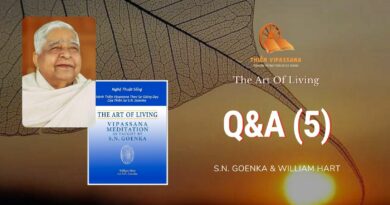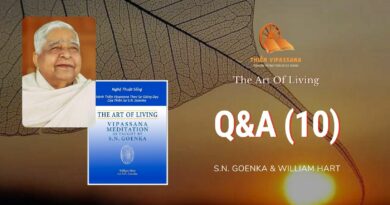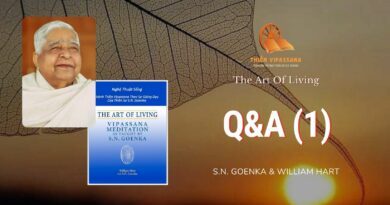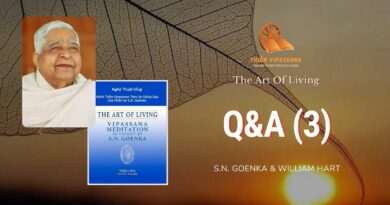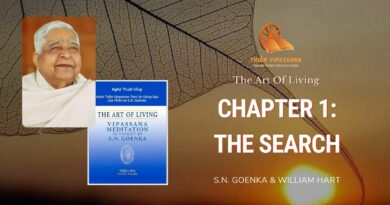GLOSSARY OF PĀLI TERMS
Included in this list are Pāli terms that appear in the text as well as some other terms of importance in the teaching of the Buddha
ānāpāna. Respiration. Ānāpāna-sati—awareness of respiration.
anattā. Not self, egoless, without essence, without substance. One of the three basic characteristics of phenomena, along with anicca and dukkha.
anicca. Impermanent, ephemeral, changing. One of the three basic characteristics of phenomena, along with anattā and dukkha. anusaya. The unconscious mind; latent, underlying conditioning;dormant mental impurity (also anusaya-kilesa).
arahant/arahat. Liberated being. One who has destroyed all impurities of the mind.
ariya. Noble; saintly person. One who has purified the mind to the point of having experienced ultimate reality (nibbāna).
ariya aṭṭhaṅgika magga. The Noble Eightfold Path leading to liberation from suffering. It is divided into three trainings, namely—
sīla. morality, purity of vocal and physical actions: sammā-vācā. right speech, sammā-kammanta. right actions, sammā-ājīva. right livelihood;
samādhi. concentration, control of one’s own mind:
sammā-vāyāma. right effort,
sammā-sati. right awareness,
sammā-samādhi. right concentration;
paññā. wisdom, insight which totally purifies the mind: sammā-saṅkappa. right thought, sammā-diṭṭhi. right understanding.
ariya sacca. Noble truth. The Four Noble Truths are (1) the truth of suffering; (2) the truth of the origin of suffering; (3) the truth of the cessation of suffering; (4) the truth of the path leading to the cessation of suffering.
bhaṅga. Dissolution. An important stage in the practice of Vipassana. The experience of the dissolution of the apparent solidity of the body into subtle vibrations that are continually arising and passing away.
bhāvanā. Mental development, meditation. The two divisions of bhāvanā are the development of tranquility (samatha-bhāvanā), corresponding to concentration of mind (samādhi), and the development of insight (vipassanā-bhāvanā), corresponding to wisdom (paññā). Development of samatha will lead to the states of mental absorption; development of vipassanā will lead to liberation.
bhāvanā-mayā paññā. Experiential wisdom. See paññā. bhikkhu. (Buddhist) monk; meditator. Feminine form
bhikkhuṇī—nun.
Buddha. Enlightened person. One who has discovered the way to liberation, has practised it, and has reached the final goal by his own efforts.
cintā-mayā paññā. Intellectual wisdom. See paññā.
citta. Mind. Cittānupassanā—observation of the mind. See sati-
paṭṭhāna.
dhamma. Phenomenon; object of mind; nature; natural law; law of liberation, i.e., teaching of an enlightened person. Dhammānu-passanā—observation of the contents of the mind. See satipaṭṭhāna. (Sanskrit dharma.)
dukkha. Suffering, unsatisfactoriness. One of the three basic characteristics of phenomena, along with anatta and anicca.
Gotama. Family name of the historical Buddha. (Sanskrit Gautama.)
Hīnayāna. Literally, “lesser vehicle.” Term used for Theravāda Buddhism by those of other schools. Pejorative connotation.
jhāna. State of mental absorption or trance. There are eight such states which may be attained by the practice of samādhi, or samatha-bhāvanā. Cultivation of them brings tranquility and bliss, but does not eradicate the deepest-rooted mental defilements.
kalāpa. Smallest indivisible unit of matter.
kamma. Action, specifically an action performed by oneself which will have an effect on one’s future. (Sanskrit karma).
kāya. Body. Kāyānupassanā—observation of the body. See sati-paṭṭhāna.
Mahāyāna. Literally, “greater vehicle.” The type of Buddhism that developed in India a few centuries after the Buddha and that spread north to Tibet, Mongolia, China, Viet Nam, Korea, and Japan.
mettā. Selfless love and good will. One of the qualities of a pure mind. Mettā-bhāvanā—the systematic cultivation of mettā by a technique of meditation.
nibbāna. Extinction; freedom from suffering; the ultimate reality; the unconditioned. (Sanskrit nirvāṇa.)
Pāli. Line; text. The texts recording the teaching of the Buddha; hence the language of these texts. Historical, linguistic, and archaeological evidence indicate that Pāli was a language actually spoken in northern India at or near the time of the Buddha. Later the texts were translated into Sanskrit, which was exclusively a literary language.
paññā. Wisdom. The third of the three trainings by which the Noble Eightfold Path is practised (see ariya aṭṭhaṅgika magga). There are three kinds of wisdom: suta-mayā paññā—literally, “wisdom gained from listening to others,” i.e., received wisdom; cintā-mayā paññā—wisdom gained by intellectual analysis; and bhāvanā-mayā paññā—wisdom developing from direct, personal experience. Of these, only the last can totally purify the mind; it is cultivated by the practice of vipassanā-bhāvanā.
paṭicca-samuppāda. The Chain of Conditioned Arising; causal genesis. The process, beginning with ignorance, by which one keeps making life after life of suffering for oneself.
samādhi. Concentration, control of one’s mind. The second of the three trainings by which the Noble Eightfold Path is practised (see ariya aṭṭhaṅgika magga). When cultivated as an end in itself, it leads to the attainment of the states of mental absorption (jhāna), but not to total liberation of the mind.
sammā-sati. Right awareness. See sati.
sampajañña. Understanding of the totality of the human phenomenon. i.e., insight into its impermanent nature at the level of sensations
saṃsāra. Cycle of rebirth; conditioned world; world of suffering.
saṅgha. Congregation; community of ariyas, i.e., those who have experienced nibbāna; community of Buddhist monks or nuns; a member of the ariya-saṅgha, bhikkhu-saṅgha, or bhikkhuṇī-saṅgha.
saṅkhāra. (Mental) formation; volitional activity; mental reaction; mental conditioning. One of the four aggregates or processes of the mind, along with viññaṇa, saññā, and vedanā. (Sanskrit samskāra.)
saṅkhāra-upekkhā / saṅkhārupekkhā. Literally, equanimity toward the saṅkhāras. A stage in the practice of Vipassana, subsequent to the experience of bhāṅga, in which old impurities lying dormant in the unconscious rise to the surface level of the mind, manifesting themselves as physical sensations. By maintaining equanimity (upekkhā) toward these sensations, the meditator creates no new saṅkhāras, and allows the old ones to be eradicated. Thus, the process gradually leads to the eradication of all saṅkhāras.
saññā. Perception, recognition. One of the four mental aggregates or processes, along with vedanā, viññāṇa, and saṅkhāra. It is ordinarily conditioned by one’s past saṅkhāras, and therefore conveys a distorted image of reality. In the practice of Vipassana, saññā is changed into paññā, the understanding of reality as it is. It becomes anicca-saññā, dukkha-saññā, anattā-saññā, asubhasaññā—that is, the perception of impermanence, suffering, egolessness, and the illusory nature of beauty.
sati. Awareness. Ānāpāna-sati-awareness of respiration. Sammā-sati-right awareness, a constituent of the Noble Eightfold Path (see ariya aṭṭhaṅgika magga).
satipaṭṭhāna. the establishing of awareness. There are four interconnected aspects of satipaṭṭhāna: (1) observation of the body (kāyānupassanā); (2) observation of sensations arising within the body (vedanānupassanā); (3) observation of the mind
(cittānupassanā); (4) observation of the contents of the mind (dhammānupassanā). All four are included in the observation of sensations, since sensations are directly related to both body and mind.
Siddhattha. Literally, “one who has accomplished his task.” The personal name of the historical Buddha. (Sanskrit Siddhārtha.)
sīla. Morality, abstaining from physical and vocal actions that cause harm to others and oneself. The first of the three trainings by which the Noble Eightfold Path is practised (see ariya aṭṭhaṅgika magga).
suta-mayā paññā. Received wisdom. See paññā.
Sutta. Discourse of the Buddha or one of his leading disciples.
(Sanskrit sūtra).
taṇhā. Literally, “thirst.” Includes both craving and its reverse image of aversion. The Buddha identified taṇhā as the cause of suffering in his first sermon, the “Discourse Setting in Motion the Wheel of Dhamma” (Dhamma-cakkappavattana Sutta). In the Chain of Conditioned Arising, he explained that taṇhā originates as a reaction to sensation (see above, p. 49).
Tathāgata. Literally “thus-gone” or “thus-come” One who by walking on the path of reality has reached the ultimate reality, i.e., an enlightened person. The term by which the Buddha commonly referred to himself.
Theravāda. Literally, “teaching of the elders.” The teachings of the Buddha, in the form in which they have been preserved in the countries of South Asia (Burma, Sri Lanka, Thailand, Laos, Cambodia). Generally recognized as the oldest form of the teachings.
Tipiṭaka. Literally, “three baskets.” The three collections of the teachings of the Buddha, namely: (1) Vinaya-piṭaka—the collection of monastic discipline; (2) Sutta-piṭaka—the collection of discourses; (3) Abhidhamma-piṭaka—“the collection of higher teaching,” i.e., systematic philosophical exegesis of the Dhamma. (Sanskrit Tripiṭaka.)
vedanā. Sensation. One of the four mental aggregates or processes, along with viññaṇa, saññā, and saṅkhāra. Described by the Buddha as having both mental and physical aspects; therefore vedanā offers a means to examine the totality of mind and body. In the Chain of Conditioned Arising, the Buddha explained that taṇhā, the cause of suffering, originates as a reaction to vedanā (see above, p. 49). By learning to observe vedanā objectively, one can avoid any new reactions of craving or aversion, and can experience directly within oneself the reality of impermanence (anicca). This experience is essential for the development of detachment, leading to liberation of the mind. Vedanānupassanā—observation of sensations within the body. See satipaṭṭhāna.
viññāṇa. Consciousness, cognition. One of the four mental aggregates or processes, along with saññā, vedanā, and saṅkhāra.
vipassanā. Introspection, insight that totally purifies the mind. Specifically, insight into the impermanent nature of mind and body. Vipassanā-bhāvanā—the systematic development of insight through the meditation technique of observing the reality of oneself by observing sensations within the body.
yathā-bhūta. Literally, “as it is.” Reality.
yathā-bhūta-ñāṇa-dassana. Wisdom arising from seeing the truth as it is.
Bài viết này được trích từ cuốn sách The Art Of Living – Thiền Sư S.N.Goenka và William Hart.

